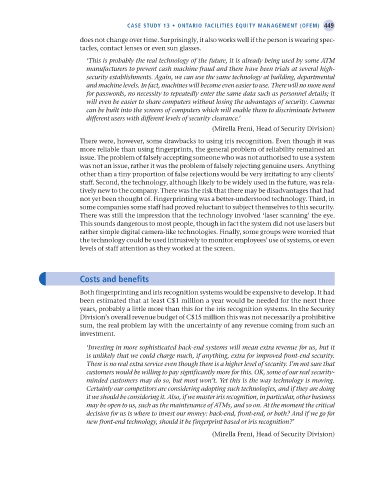Page 474 - Operations Strategy
P. 474
case study 13 • OntariO facilities equity management (Ofem) 449
does not change over time. Surprisingly, it also works well if the person is wearing spec-
tacles, contact lenses or even sun glasses.
‘This is probably the real technology of the future, it is already being used by some ATM
manufacturers to prevent cash machine fraud and there have been trials at several high-
security establishments. Again, we can use the same technology at building, departmental
and machine levels. In fact, machines will become even easier to use. There will no more need
for passwords, no necessity to repeatedly enter the same data such as personnel details; it
will even be easier to share computers without losing the advantages of security. Cameras
can be built into the screens of computers which will enable them to discriminate between
different users with different levels of security clearance.’
(Mirella Freni, Head of Security Division)
There were, however, some drawbacks to using iris recognition. Even though it was
more reliable than using fingerprints, the general problem of reliability remained an
issue. The problem of falsely accepting someone who was not authorised to use a system
was not an issue, rather it was the problem of falsely rejecting genuine users. Anything
other than a tiny proportion of false rejections would be very irritating to any clients’
staff. Second, the technology, although likely to be widely used in the future, was rela-
tively new to the company. There was the risk that there may be disadvantages that had
not yet been thought of. Fingerprinting was a better-understood technology. Third, in
some companies some staff had proved reluctant to subject themselves to this security.
There was still the impression that the technology involved ‘laser scanning’ the eye.
This sounds dangerous to most people, though in fact the system did not use lasers but
rather simple digital camera-like technologies. Finally, some groups were worried that
the technology could be used intrusively to monitor employees’ use of systems, or even
levels of staff attention as they worked at the screen.
costs and benefits
Both fingerprinting and iris recognition systems would be expensive to develop. It had
been estimated that at least C$1 million a year would be needed for the next three
years, probably a little more than this for the iris recognition systems. In the Security
Division’s overall revenue budget of C$15 million this was not necessarily a prohibitive
sum, the real problem lay with the uncertainty of any revenue coming from such an
investment.
‘Investing in more sophisticated back-end systems will mean extra revenue for us, but it
is unlikely that we could charge much, if anything, extra for improved front-end security.
There is no real extra service even though there is a higher level of security. I’m not sure that
customers would be willing to pay significantly more for this. OK, some of our real security-
minded customers may do so, but most won’t. Yet this is the way technology is moving.
Certainly our competitors are considering adopting such technologies, and if they are doing
it we should be considering it. Also, if we master iris recognition, in particular, other business
may be open to us, such as the maintenance of ATMs, and so on. At the moment the critical
decision for us is where to invest our money: back-end, front-end, or both? And if we go for
new front-end technology, should it be fingerprint based or iris recognition?’
(Mirella Freni, Head of Security Division)
Z13 Operations Strategy 62492.indd 449 02/03/2017 13:58

